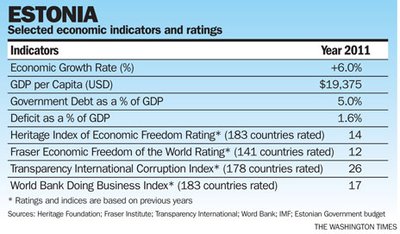What We Can Learn From Estonia
From the desk of Richard Rahn on Wed, 2011-06-29 12:52
Tallinn, Estonia. Most Eastern European countries that were controlled by the communists have had successful political/economic transitions and are far more prosperous than they were two decades ago - but none has come as far as Estonia.
The Estonians are closely related to the Finns, and their languages are close as well. Tallinn, the capital of Estonia, is only about 50 miles from Helsinki, the capital of Finland, and they are in commuting distance by hydrofoil across the Gulf of Finland. Before the Soviet Union conquered Estonia in 1939, the Estonians and Finns had close to the same standard of living. But the Finns were able to maintain their freedom by conducting a vigorous defense against the Soviet invasion in 1939.
The Finnish economy prospered after World War II, while the Estonian economy was destroyed by the Soviets. By 1987, it is estimated that the Finns were seven times richer per capita than the Estonians.
Ever since they regained their freedom in 1991, as a result of undertaking the most radical free-market reforms of any of the transition countries, the Estonians have been gaining on their Finnish neighbors, who also have continued to do well, and now have about two-thirds of the per capita income of the average Finn.
My first trip to Estonia came when it was still under Soviet occupation. Basic goods, including many foods, were scarce. Tallinn was a dangerous city after dark, as drunken bands of Russian soldiers wandered the streets taking whatever liberties they wished.
The old town in Tallinn is one of the most picturesque medieval places on the planet, but the communists let it decay - like everything else they touched. I remember thinking, how glorious it would be if it were restored. Once property rights were re-established after the Estonian Singing Revolution and liberation more than 20 years ago, the old town was quickly restored and it is indeed glorious.
In 1992, a 32-year old historian by the name of Mart Laar became prime minister. As Mr. Laar often mentions, at the time he had only read one economics book and that was Milton Friedman's Free to Choose. He says, "It sounded good to me so we went ahead and did it."
Under Mr. Laar's leadership, they did not diddle with reform, they went at it on all fronts full speed ahead - "shock therapy." They re-established the rule of law, property rights and were serious about getting rid of corruption. They opened themselves to trade and privatized most of the economy. Also, they instituted a flat tax, which was quickly copied by many other countries, including Russia.
In 2004, Estonia joined the European Union and NATO, and adopted the euro in January 2011, which, in retrospect might have been a mistake, given the debt burdens of many of the euro economies.

As can be seen in this chart, the Estonians have done many things right, but still have some problems.
Estonia is one of the most economically free countries in the world and it is easy to do business there. It has the lowest debt/GDP ratio in Europe and has maintained fiscally sound policies, unlike most countries, including the United States.
It had a boom from 2003 to 2008 when the economy grew by more than 8 percent a year, but, like the U.S. and many other places, a property bubble developed and the crash of 2009 resulted in a sharp drop in gross domestic product and a huge increase in unemployment.
The good news is Estonia is now back on a growth path and, unlike the U.S., is still following free-market principles; the expectation is it will soon recover its lost ground.
It is a tribute to Mart Laar that during his two terms as prime minister (1992-1994 and 1999-2002) and in the years since, despite different parties controlling the government, the basic economic policies and freedoms that he had a major role in designing and implementing are still in place.
Estonia serves as an example - even or especially for the United States - of what can be accomplished by keeping down deficits and debt, and utilizing a flat tax rather than a progressive income tax.
The Estonians have also been the leaders in utilizing e-government whereby most government-citizen interactions are done over the Internet, which reduces both cost and bureaucracy. Every country could benefit from this Estonian innovation. Helping them do so is the e-Governance Academy established here in Tallinn.
